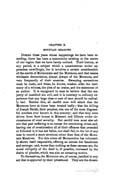
[p. 273]
CHAPTER X
MOUNTAIN MEADOWS.
During these years whose happenings we have been recording, there has been a community existing in the centre of our region that we have barely noticed. Their history, at any period, is a subject which a conscientious writer approaches unwillingly, for it involves a certain consideration of the merits of Mormonism and the Mormons, and that means wholesale denunciation, almost always of the Mormons, and very frequently of their enemies. Sweeping accusations must be made, and these, he knows, weaken alike the testimony of a witness, the plea of an orator, and the statement of an author. It is repugnant to man to believe that the majority of mankind are evil, and it is contrary to ordinary experience that any large class or sect of men should be radically bad. Besides this, all candid men will admit that the Mormons have at times been treated badly; that the killing of Joseph Smith, their prophet, was one of the most disgraceful murders ever known in this country; and that they were driven from their homes in Missouri and Illinois under circumstances of cruel severity. But candid men must also admit that past sufering is no excuse for continuing crime, and, leaving out of consideration all of their offences that preceded or followed it, it has not fallen, nor shall fall, to the lot of any man to record a more atrocious crime than that of the Mountain Meadows. For this crime all Mormondon has voluntarily shown itself responsible, offering no excuse but fanaticism and revenge; and, worse than nothing as these excuses are, the moral obliquity of the deed is, if possible, increased by the desire of plunder, which was also an actuating motive.
To themselves, the Mormons are, of course, justified in any
act that is approved by their priesthood. They are the chosen
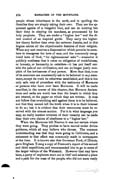
[p. 274]
people whose inheritance is the earth, and in spoiling the
Gentiles they are simply taking their own. They are the
appointed agents of a vengeful God, and can do nothing but
their duty in obeying his mandates, as pronounced by his
holy prophets. They are under a "higher law" and the
direct control of an inspired guide. They carry the higher
law theory farther than even the extreme Jesuits, and in this
dogma centre all the objectionable features of their religion.
When any sect receives a dispensation which permits its
members to transgress the laws of man, and the commonly recognized
laws of God, "for righteousness' sake" —whenever it
publicly confesses that it owns no obligation of truthfulness,
or honesty, or humanity, to outsiders—it has put itself
outside the pale of our civilization, and can no longer justly
complain of the lawlessness of any person. More than that, none
of its members can consistently ask to be believed in any statement,
except its truth be otherwise established, and this is the
only safe rule of procedure with the testimony of Mormons
or persons who have ever been Mormons. It will be made
manifest, in the course of this chapter, that Mormon declarations
and oaths are worth less than the breath in which they
are uttered, or the paper on which they are written. It does
not follow that everythinglsaid against them is to be believed,
nor that they cannot tell the truth when it is to their interest
to do so; but it is evident that their statements must be
received with the utmost caution. Put it in what language you
may, no really harsher criticism of their veracity can be made
than their own claims of obedience to a "higher law."
When the Mormons left Nauvoo it was not certain where
they were going. They profess to have moved under divine
guidance, which all may believe who choose. The common
understanding was that they were going to California, and a
statement to that effect was commonly made in newspapers
at the time. It is known also that Governor Ford, of Illinois,
gave Brigham Young a copy of Fremont's report of his second
and third expeditions, and recommended him to go to some of
the larger valleys of the Wahsatch. However that may have
been, a party of explorers went out in 1847 and selected a place
and a path for the mass of the people, who did not seem ready
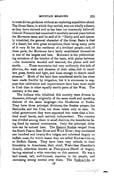
[p. 275]
to trust divine guidance without an exploring expedition ahead.
The Great Basin, in which they settled, was not wholly a desert,
as they have claimed and as has been too commonly believed.
Colonel Fremont had examined it carefully several years before
the Mormons came, and he said of it: "Partly arid and sparsely
inhabited, the general character of the Great Basin is that
of a desert, but with great exceptions, there being many parts
of it very fit for the residence of a civilized people; and, of
these parts, the Mormons have lately established themselves
in one of the largest and best. Mountain is the predominating
structure of the interior of the basin, with plains between
—the mountains wooded and watered, the plains arid and
sterile .... These mountains had very uniformly this belt of
alluvion, the wash and abrasion of their sides, rich in excellent
grass, fertile and light, and loose enough to absorb small
streams." Much of the land then considered sterile has since
been made fruitful by irrigation, but it is erroneous to suppose
that cultivation and improvement have been more rapid
in Utah than in other equally sterile parts of the West. The
contrary is the case.
The Indians who inhabited this country were diverse in
character, although originally of the same stock and speaking
dialects of the same language—the Shoshonee or Snake.
They have three principal divisions, the Snakes proper, the
Bannocks, and the Utes, but these relate only to race. In
tribal government they were separated into more than a hundred
small bands, each entirely independent. The country
was divided among them in small districts, the boundaries being
fixed by natural monuments. Only the principal divisions
can be noticed here. The Eastern Snakes ranged from
the South Pass to Bear River and Wind River; they numbered
one hundred and twenty—five lodges, and subsisted largely on
buffalo meat, for which reason they are called Kool—sa—ti—ka—ra,
or Buffalo Eaters. They have been very reliable in their
friendship to Americans, their chief, Wash—i—kee (Gambler`s
Gourd), otherwise known as Pina—qua—na (Smell of Sugar),
having attained a wide notoriety on this account. He was a
half—breed, tall, well—formed, superior to his people, and
exercising strong control over them. The Took—a—ri—ka, or

[p. 276]
WASHAKIE.
Mountain—Sheep Eaters ranged high up on the mountains, Usually, and had little to do with the whites. They were an extraordinary people, building their rude houses above timber line on the mountain henghts, and seeming doomed to so cheerless a life that the Canadian trappers gave them the name “les dignes de pitie," or, the objects of pity. On the Salmon River was a mixed band, largely of their people, which numbered fifty lodges. Its principal chief was Qui—tan—i—wa (Foul Hand), and his sub—chiefs were "Old Snag," an Eastern Snake, and "Grand Coqnin," a Bannock. Their friendship was always questionable. The Western Qngkes were in two main bands,one under Am—a—ro—ko (Buffalo Meat under the Shoulder), ranging on Camas Prairie, and the other under Po—ca—ta—ra (White Plume), ranging in the Goose Creek Mountains and on the Humboldt. They numbered about one hundred and fifty lodges, and were on good terms with the Mormons, but not with other whites. They are commonly called Sho—sho— kos, or "White Knives," from the white flint knives they formerly used. A large band of the Bannocks ranging west of the Blue Mountains were known as thc War—g—ri—kgs, or "Sunflower—Seed Eaters.They numbered one hundred and fifty lodges, were commanded by Pa—chi—co (Sweet Root), a mighty medicine man, and were hostile when favorable opportunities occurred. In the neighborhood of Fort Boisée were one hundred lodges of Bannocks, under Po—e—ma—chee—ah (Hairy Man), who were the most friendly of their race towards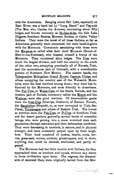
[p. 277]
the Americans. Ranging about Salt Lake, especially on Bear River, was a band led by "Long Beard" and Pag—e—ah (The Man who Carries the Arrows), numbering about fifty lodges, and known variously as Ho—kan—di—ka, the Salt Lake Diggers, Southern Snakes, Mormon Snakes, or Cache Valley Indians. They were the worst of all these Indians, so far as Americans generally were concerned, but were haud—in—glove with the Mormons. Commonly associating with these were the Mo—pe—,so called after their chief Mo—pe—ah (Bunch—of Hair—in—the—Forehcad), who boasted himself a friend of the Mormons. They numbered sixty lodges. The Utes were much the largest division, and held the country to the south of the other two, occupying practically all of Nevada, Utah, and the mountainous part of Colorado, with a considerable portion of Northern New Mexico. The eastern bands, the Tabgquaches, Mohuaches, Grand Rivers, Capotes, Uintas, and others occupying the country east of the Wahsatch Mountains, were the best warriors among them; they were less influenced by the Mormons, and most friendly to Americans. The Pali—Utes, or, of the Sierra Nevada, and the western part of Nevada, commonly called the Monos and the Waslioes, were also good warriors. Of intermediate grade were the Gosi—Utes (Goships, Goshoots) of Eastern Nevada, the Sanpitches (Sinpichi, or, as now corrupted in Utah, San Petes), Timpanagos, and others of Eastern Utah. The lowest as warriors were the Bah—Utes, or Pi—Utes of Southern Utah and the desert portions generally, several bands of miserable beings, who were getting into a more wretched state each generation,through starvation and their defenceless condition. They were decreasing in numbers, in stature, and in physical strength, and were constantly preyed upon by their neighbors. Their food consisted of snakes, lizards, roots, berries, grass—seed, worms, crickets, grasshoppers, and, in short, anything that conld be chewed, swallowed, and partly digested.
The Mormons had but little trouble with Indians, for they
approached them as brothers and equals, without any desire
to force civilization upon them. The negroes, the descendants
of accursed Ham, were originally barred from the Mormon

[p. 278]
heaven, though latterly a revelation has been made which
lets them in, but the Indians were always brothers. They are
"Lamanites," the "remnant" of the lost tribes of Israel, lineal
descendants of Abraham, sprays from the "fruitful bough
by a well, whose branches run over the wall," who are to be
reclaimed by Mormon righteousness, and in due time to become
"a fair and delightsome people." The Mormons brought to
the Indians a religion and customs differing in but one essential
respect from what they already had, and that was obedience
UTE SQUAWS OF UTAH.
to the Mormon prophet. This duty was largely bought by presents (usually purchased with United States' funds) and protection, and was further induced by missionary work and intermarriage. Their protection of the Indians who adhered to them was sufficient to prevent any punishment for their crimes. The case of the murderers of Lieutenant Gunnison will illustrate this. Gunnison had wintered at Salt Lake in company with the remainder of Captain Stansbury's party,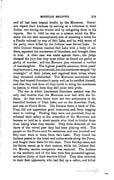
[p. 279]
and all had been treated kindly by the Mormons. Gunnison repaid their kindness by serving as a volunteer in their Indian war during the winter, and by eulogizing them in his reports. But in 1853 he was on a mission which the Mormons did not wish accomplished, that of selecting a route for a Pacific railroad by way of Salt Lake, and he, with seven of his party, were killed by the Indians near Sevier Lake. In 1854 Colonel Steptoe reached Salt Lake with a body of soldiers, captured the murderers of Gunnison, and brought them to trial. A clear case was made against them; the judge charged the jury that they must either be found not guilty or guilty of murder; and the Mormon jury returned a verdict of manslaughter. The highest possible sentence, three years' imprisonment, was pronounced, but the murderers escaped "by oversight" of their jailers, and regained their tribes, where they remained undisturbed. The Mormons announced that they had treated Gunnison's party well, as he testified himself, and that they had done all they could to bring his murderers to justice, to which facts they still point with pride.
The war in which Lieutenant Gunnison assisted was the
only real trouble that the Mormons ever had with the Indians.
At that time there were but two settlements in the
beautiful borders of Utah Lake, one on the American Fork,
and one on Provo River. The Indians there, a band of Pah—
Utes, did not appreciate good treatment, and from begging
went to robbing. Finding they were not punished, they attributed
their safety to the cowardice of the Mormons, and
became so bold as to shoot people who tried to hinder them
from taking what they wanted. They little dreamed of the
claws of the velvet paw they had been playing with. The
people on the Provo sent for assistance, and one hundred and
fifty men went to them from Salt Lake. They found the
Indians posted in the brush and cottonwoods along the Provo,
and fought them there for two days. Then Sunday came, and
the Saints rested, as is their custom, while the Indians fled.
On Monday secular occupation was resumed. The Indians
at the southern end of the lake were first proceeded against,
and about thirty of their warriors killed. They then returned
to their first opponents, who had fled up a canon, and killed
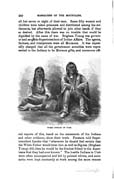
[p. 280]
all but seven or eight of their men. Some fifty women and
children were taken prisoners and distributed among the
settlements, but afterwards allowed to join other bands if they
so desired. After this there was no trouble that could be I
dignified by the name of war. Brigham Young was governor
and ex—offcio Superintendent of Indian Afairs. The agents,
farmers, and interpreters were all Mormons. It was repeatedly
charged that all the government annuities were represented
to the Indians to be Mormon gifts, and numerous official
SNAKE INDIANS OF UTAH.
reports of this, based on the statements of the Indians and other evidence, show their truth. Pocatara told Superintendent Lander that “whenever he should feel certain that the White Father would treat him as well as Big-um (Brigham Young) did, then he would be the kindest friend to the Americans that they had ever known." The hostile Indians in Utah were often accompanied and led by painted whites, and emissaries were kept constantly at work among the more remote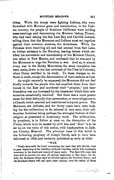
[p. 281]
tribes. While the troops were fighting Indians, who were furnished with Mormon gnns and ammunition, in the Yakima country, the people of Southern California were holding mass—meetings and denouncing the Mormon bishop, Tinney, who had been among the San Luis Rey and Carvilla Indians, telling them that the Mormons and Indians must act together against their common enemies, the Americans. While the Pelouses were receiving aid and bad counsel from Salt Lake, an Indian emissary to the Navahos, bearing letters which certified his conversion and membership of the Mormon Church, was taken in New Mexico, and confessed that he was sent by the Mormons to urge the Navahos to war. And so, in almost every war in the Rocky Mountains, the same complaint has been made, down to the last outbreak of the Utes in Colorado, when Ouray certified to its truth. To these charges no defence is made, except the denunciation of their authors as liars.
As might naturally be supposed, the Mormons did not feel kindly towards the people who had expelled them from their homes in the East and murdered their "prophet," and their friendship was not increased by the treatment which their missionaries occasionally received. But there was a more potent cause for their disloyalty than persecntion,or mere allegiance to a Church which asserted and maintained temporal power. The Mormons are chiliasts, and for thirty years have been looking for the millennium to be ushered in very soon, their millenarian doctrines being perhaps the strongest feature of their religion as presented in missionary work. The millennium, by prophecy, is to follow at once on the disruption of the Union, which is to be caused by civil war, and "Zion" is to be set up on the ruins of this nation, with headquarters in Jackson County, Missouri. The principal basis of this belief is the following prophecy of Joseph Smith, said to have been delivered in 1832, and certainly published as early as 1854:
"WAR
."Verily thus saith the Lord concerning the wars that will shortly come
to pass, beginning at the rebellion of South Carolina, which will eventually
terminate in the death and misery of many souls. The days will come that
wars will be poured out upon all nations, beginning at that place; for, behold,
the Southern States shall be divided against the Northern States; and
the Southern States will call upon other nations, even the nation of Great
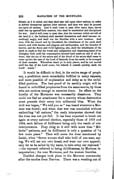
[p. 282]
Britain, as it is called, and they shall also call upon other nations, in order
to defend themselves against other nations: and thus war shall be poured
out upon all nations. And it shall come to pass, after many days, slaves
shall rise up against their masters, who shall be marshalled and disciplined
for war. And it will come to pass, also, that the remnant which are left of
the land [i. e., the Indians] shall marshal themselves and shall become
exceedingly angry, and shall vex the Gentiles with a sore vexation. And
thus, with the sword and by bloodshed, the inhabitants of the earth shall
mourn, and with famine and plagues and earthquakes, and the thunder of {
heaven, and the fierce and vivid lightning, also, shall the inhabitants of the
earth be made to feel the wrath and indignation and chastening hand of an
Almighty God, until the consumption decreed hath made an end of all nations;
that the cry of the saints and of the blood of the saints shall cease to
come up into the ears of the Lord of Sabaoth, from the earth, to be avenged
of their enemies. Wherefore stand ye in holy places, and be not moved
until the day of the Lord come; for, behold, it cometh quickly, saith the
Lord! Amen."
It would be difficult to find, in the entire range of prophecy, a prediction more remarkably fulfilled in many respects, and more possible of explanation and delay as to the unfulfilled portions. The best proof of its earthly origin will be found in unfulfilled prophecies from the same source, by those who are curious enough to examine them. Its effect on the loyalty of the Mormons was necessarily disastrous. They could not feel an attachment for a country whose destruction must precede their entry into millennial bliss. When the civil war began, "We told you so" was heard wherever a Mormon was found; and when that war was concluded. without embroiling "all nations," the ready interpreter showed that the time was not yet full. It has been expected to break out again at every national election, especially those of 1876 and 1884, each failure of fulfilment being only the result of misinterpretation. They cling to it still with more than "Millerite" patience, and its fulfilment is only a question of "a few more years." Then will come the time mentioned by Isaiah, when "Seven women shall take hold of one man, saying, We will eat our own bread, and wear our own apparel: only let us be called by thy name, to take away our reproach " —the reproach referred to being childlessness, by Mormon interpretation; the men Mormons, and the women Gentiles.
Decided changes took place in the Mormon community
after the exodus from Nauvoo. There was a weeding out of
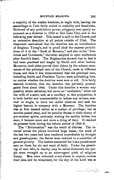
[p. 283]
a majority of the weaker brethren, to begin with, leaving the
assemblage in Utah fairly united in credulity and fanaticism.
Relieved of any prohibitory power, polygamy was openly
announced as a doctrine in 1852 at Salt Lake City, and in the
following year abroad. This caused a split in the Church, and
an extensive desertion at all points outside of Utah. The
dissenters maintained that the doctrine was an introduction
of Brigham Young's, and in proof cited the express prohibitions
of it in the " Book of Mormon," and also in the "Doctrines
trines and Covenauts," the latter adopted in open conference
after Smith's death. The Brighamites showed that in fact it
had been practised and taught by Smith and other leaders.
Moreover, both sides proved their claims by the solemn statements
of the principal men of the Church, made at different
times, and thus it was demonstrated that the principal men,
including Smith and President Taylor, were unblushing liars,
no matter whether the doctrine were new or old. It is fairly
assured, however, that the doctrine was privately promulgated
from about 1844. Under this doctrine a woman may
possibly attain salvation, but never an "exaltation," when not
the wife of a saint, and, as a corollary to this proposition, it
is both lawful and commendable to induce any woman,
married or single, to leave her sinful relatives and seek the
higher heaven in company with a Mormon. The doctrine
was at first treated rather as a matter of privilege; but as
months passed away, and its peculiar fitness to their theory of
pre—existent spirits, anxiously waiting for earthly bodies, was
seen, it became more and more a thing of duty. It reached
its grossest form during the reform period of 1855—6.
The "Reformation" was the result of distress. The
removal across the plains involved large losses; the work of
the last two years had been rendered unprofitable by drought
and grasshoppers; the Saints were reduced to a condition of
general poverty. The leaders accounted for it as a punishment
sent on them for sin and want of faith. Under the preaching
of men who, in charity, may be called demented, the people
were wrought up to an extravagant pitch of religious
frenzy. Men were exhorted everywhere to repent, confess
their sins, and be rebaptized, for the day of the Lord was at
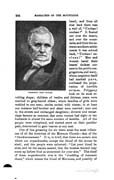
[p. 284]
PRESIDENT JOHN TAYLOR.
hand; and from all that land there rose a wail of, "Unclean! unclean!" It floated out over the desert, and Over the mountains, and from the extreme southern settlements it was echoed back, "Uncleanl unclean!" Men and women bared their hearts' darkest corners to the public congregations,and many, whom suspicion itself had marked pure, confessed the perpetration of horrible crimes. Polygamy took on its most revolting shape; children of twelve and thirteen years were married to gray—haired elders; whole families of girls were wedded to one man; uncles united with nieces; in at least one instance half—brother and sister were married; men met in the streets and exchanged daughters; divorce and remarriage became so common that some women had eight or ten husbands in almost the same number of months. All of the people were rebaptizcd, and started anew on their peculiar path, determined to gain heaven at any cost.Out of this groaning for sin there arose the most villainons
of all the doctrines of the Mormon Church—that of the
"blood—atonement." It is, in brief, that there are certain sins
which are unpardonable, except the blood of the sinner be
shed; and the people were exhorted: "Let your blood be
shed, and let the smoke ascend, that the incense thereof may
come up before God as atonement for your sins." The chief
of these unpardonable sins is the "shedding of innocent
blood," which means the blood of Mormons, and possibly of
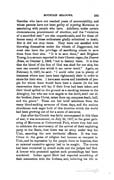
[p. 285]
Gentiles who have not reached years of accountability, and
whose parents have not been guilty of injuring Mormons or
associating with people who have. Adultery, under certain
circumstances, procurement of abortion, and the "violation
of a sanctified oath" are also unpardonable, and for these
offences many of these enthusiasts gladly submitted to death.
But it did not stop there. They were not satisfied with
throwing themselves under the wheels of Juggernant, but
must also have the privilege of sacrificing others to save
them from their sins. "It is to save them," said Brigham
Young, in a sermon reported in their Church organ, the Deseret
News, on October 1, 1856, "not to destroy them. It is true
that the blood of the Son of God was shed for our sins, but
men can commit sins which it can never remit." Again, on
February 8, 1857, he said: "I could refer you to plenty of
instances where men have been righteously slain in order to
atone for their sins. I have seen scores and hundreds of
people for whom there would have been a chance (in the last
resurrection there will be) if their lives had been taken, and
their blood spilled on the ground as a smoking incense to the
Almighty, but who are now angels to the devil,until our
elder brother, Jesus Christ, raises them up, conquers death, hell,
and the grave." These are but brief selections from the
many blood—seeking sermons of those days, and the zealous
churchmen took eager hold of this doctrine which the world
had been growing out of for a score of centuries.
Just after the Church was fairly encompassed in this blaze
of zeal, it was announced, on July 24, 1857, to the great
gathering of Mormons at Cottonwood Park, where they had met
to celebrate the anniversary of the arrival of their exploring
party in the Basin, that there was an army under way for
Utah, escorting the new territorial officers. It was true.
Crime in the guise of religion had become so rampant in
Utah, and its repression by the people there so hopeless, that
an external executive agency had to be sought. The courts
had been overawed by armed mobs and the judges had fled.
A lawyer who protested against such proceedings had been
murdered. Indian agent Hurt had reported something of
their connection with the Indians, and, believing his life in
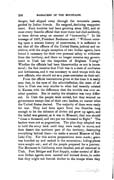
[p. 286]
danger, had slipped away through the mountain passes,
guided by Indian friends. He resigned, declining reappointment.
Such troubles had been growing since 1851, and almost
every Gentile official that went there had died suddenly,
or been driven away on account of "immorality." In his
message of 1857, President Buchanan said: "Without entering
upon a minute history of occurrences, it is sufficieut to
say that all the officers of the United States, judicial and
executive, with the single exception of two Indian agents, have
found it necessary for their own personal safety to withdraw
from the territory, and there no longer remains any
government in Utah but the despotism of Brigham Young."
Whether the officials had been blameworthy or not is inunaterial;
the fact remains that Utah was in a state of confusion
and lawlessness, and it was necessary to send troops with the
new officials, who should act as a posse comitatus on their call.
From the official instructions given at the time it is easily
seen that, in the eyes of the administration, the state of
affairs in Utah was very similar to what had recently existed in Kansas, with the difference that the trouble was over another question. But in reality the situation was very diferent.
In Utah the people were united, but they wanted no
government except that of their own leaders, no matter what .
the United States desired. The majority of them were ready
for war. They had been apart from the Gentiles long
enough to let the delusion of divine aid grow up again, and
the belief was general, as it was in Missouri, that one should
"chase a thousand, and two put ten thousand to flight." The
leaders were not so pugnacious. The plan they adopted was
to hold the army back until they were ready to move, and
then desert the northern part of the territory, destroying
everything behind them—to make a second Moscow of Salt
Lake City. For this active preparations were made; grain
was hoarded up and cached in the mountains; hiding-places
were sought out; and all the people prepared for a journey.
The Mormons in California were recalled, and all returned to
Utah. Fort Bridger and Fort Supply, under control of Mormon
Indian agents, were vacated and burned down, in order
that they might not furnish shelter to the troops when they
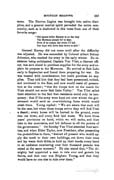
[p. 287]
came. The Nauvoo Legion was brought into active discipline,
and a general martial spirit pervaded the entire community,
such as is shadowed in this verse from one of their
favorite songs:
General Harney did not come until after the difficulty was adjusted. He was succeeded by Colonel Albert Sidney Johnston, who reached the army in the early winter. No resistance being anticipated, Captain Van Vliet, a discreet officer, was sent ahead to purchase supplies for the army and explain its purpose to the Mormons. He arrived at Salt Lake early in September and found them preparing for war. He was treated with consideration, but could purchase no supplies. They told him that they had been persecuted, robbed, and murdered in the East, and now would resist all persecution at the outset; "that the troops now on the march for Utah should not enter Salt Lake Valley." Van Vliet called their attention to the fact that resistance could only be temporary; that if the army were kept out over winter the government would send an overwhelming force which would crush them. Young replied: "We are aware that such will be the case, but when those troops arrive they will find Utah a desert; every house will be burned to the ground, every tree cut down, and every Held laid waste. We have three years' provisions on hand, which we will cache, and then take to the mountains, and bid defiance to all the powers of the government." On Sunday Van Vliet attended their services, and when Elder Taylor, now President, after presenting the probabilities to them, "desired all present who would apply the torch to their own buildings, cut down their trees and lay waste their fields, to hold up their hands, every hand in an audience numbering over four thousand persons was raised at the same moment." He also stated that, "The ALmighty had appointed a man to rule over and govern his Saints, and that man was Brigham Young, and that they would have no one else to rule over them."
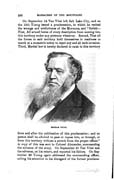
[p. 288]
On September 14 Van Vliet left Salt Lake City, and on the 15th Young issued a proclamation, in which he recited the wrongs and misfortunes of the Mormons, and "forbid— First, All armed forces of every description from coming into this territory under any pretence whatever. Second, That all the forces in said territory hold themselves in readiness to march at a moment's notice to repel an and all such invasion. Third, Martial law is hereby declared to exist in this territory
BRIGHAM YOUNG.
from and after the publication of this proclamation; and no person shall be allowed to pass or repass into, or through, or from this territory without a permit from the proper oflicer." A copy of this was sent to Colonel Alexander, commanding the advance of the army. On September 21 Van Vliet met the advance, on his return, and reported his failure. On September 29 Young again addressed the commanding officer, calling his attention to his disregard of the former proclama-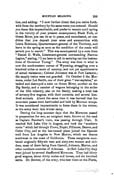
[p. 289]
tion, and adding: "I now further direct that you retire forthwith from the territory by the same route you entered. Should you deem this impracticable, and prefer to remain until spring in the vicinity of your present encampment, Black Fork, or Green River, you can do so in peace, and unmolested, on condition that you deposit your arms and ammunition with Lewis Robinson, Quartermaster—general of the Territory, and leave in the spring as soon as the condition of the roads will permit you to march." This was accompanied by a note from "Daniel H. Wells, Lieutenant—general commanding Nauvoo Legion," stating, " I am here to aid in carrying out the instructions of Governor Young." The army was then in what is now the southwestern corner of Wyoming, straggling over a hundred miles or more of country, and not yet apprehensive of actual resistance; Colonel Johnston was at Fort Laramie; the supply trains were not guarded. On October 5 the Mormons, under Lot Smith, one of their great "war—captains," attacked and destroyed a train on Green River, another on the Big Sandy, and a number of wagons belonging to the sutler of the 10th infantry, also on the Sandy, making a total loss of seventy—five wagons, with their contents, and several hundred animals. About the same time it was learned that the mountain passes were barricaded and held by Mormon troops. It was considered impracticable to force them in the winter, so the army went into winter camp.
During the long summer days that the Mormons passed
in preparation for war, an emigrant train, known on the road as Captain Fancher's train, was passing through Utah. It reached Salt Lake City in August, and took the "southern route" which led through Provo, Nephi, Fillmore, Beaver, and Cedar City, and at the last—named place joined the Spanish trail from Los Angeles to New Mexico, which ran thence southwest to the coast of California. These emigrants numbered originally fifty-six men and sixty-two women and children, most of them being from Carroll, Johnson, Marion, and other northern counties of Arkansas. At Salt Lake City they were joined by several disaffected Mormons. They had thirty
good wagons, about thirty mules and horses, and six hundred
cattle. Dr. Brewer, of the army, who met them on the Platte,
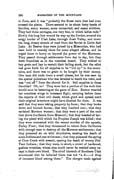
[p. 290]
in June, said it was "probably the finest train that had ever
crossed the plains. There seemed to be about forty heads of
families, many women, some unmarried, and many children.
They had three carriages, one very fine, in which ladies rode."
Slowly this long line wound its way up the Jordan, around the
sedgy border of Utah Lake, through Juab Valley, and down
the long, dreary stretch of road from the Sevier to Little Salt
Lake. At Beaver they were joined by a Missourian, who had
been held in custody there for some alleged offence, and he
urged them to hurry on beyond the power of the Mormons.
They passed through settlements from day to day, but they
were friendless as in the voiceless desert. They wished to
buy grain and hay to recruit their failing stock, but the edict
had gone forth for all supplies to be "hid up" in the mountains,
and there was no grain to be bought by their money.
One man did trade them a small cheese, but he was seen by
the special policeman who was detailed to watch the train, and
was "cut off" from the church for it. Sell supplies to these
Gentiles? Oh, no! They were but a portion of the mob that
would soon be battering at the gates of Zion. Rumor wearied
her countless wings in incessant flight, carrying before them
the reports of their evil deeds, which grew and spread until
their original inventors might have blushed for them. It was
said that they were taking property by force; that they broke
down and burned fences; that they insulted men; that they
ravished Mormon women; that they were a part of the mob
that drove the Saints from Missouri; that they boasted of having
the pistol with which the Prophet Joseph was killed ; that
they were connected with the recent murder of the apostle,
Parley Pratt; that they threatened to return from California
with enough men to destroy all the Mormon settlements; that
they poisoned an ox with strychnine, causing the death of
some Indians and one white man; that they poisoned the spring
at Corn Creek with arsenic, causing the death of twenty Pah-
Vaut Indians; that they were, in short, a crowd of hardened,
godless wretches, whose sins could never be washed away except
in their own blood. The chief hierarch of Southern Utah
announced that he believed there was not "a d—d drop
of innocent blood among them." The charges made against
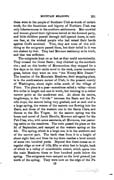
[p. 291]
them were to the people of Southern Utah as words of certain truth, for the fanaticism and bigotry of Northern Utah was only lukewarmness in the southern settlements.Beaver Men scowled
and women glared their righteous hatred at the doomed party,
and little children peered through half-opened doors, in curious
fear, at the wicked people who had raised their hands
against God's anointed. True, they saw none of this evildoing
as the emigrants passed them, but their belief in it was
not shaken by that. They had Mormon testimony to its truth,
and that was sufficient.
The emigrants kept on as fast as they could conveniently.
They crossed the Great Basin; they climbed up the southern
rim; and on this border of Mormondom they stopped for a
few days to let their cattle revel in the rank, coarse mountain
grass, before they went on into "the Ninety-Mile Desert."
The location of the Mountain Meadows, their stopping-place, is in the southwestern corner of Utah, in the present county of Washington, about eight miles south of the village of Pinto. The place is a pass—sometimes called a valley—about
five miles in length and one in width, but running to a rather
narrow point at the southwest end. At about its centre,
lengthways, is the "divide" between the Basin and the
Pacific slope, the ascents being very gradual, and at each end is
a large spring, the waters of the eastern one flowing into the
Basin, and those of the western one to the Santa Clara, and
thence to the Rio Virgen. At the eastern spring was the
house and corral of Jacob Hamlin, Mormon sub-agent for the
Pah-Utes, who, with some assistants, all Mormons, was pasturing
cattle on the meadows. The train passed his place on the
3d of September, and camped at the western spring on the
4th. The spring, which is a large one, is in the southern end
of the narrow part. The bank rises from it to a height of
about eight feet, and from its top there reaches a level stretch
of some two hundred yards. Beyond this there comes an
irregular ridge or row of hills, fifty or sixty feet in height, back
of which is a valley of considerable extent, which opens into
the main Meadows three or four hundred yards below the
spring. The emigrants were camped on the level ground just
north of the spring. They were now on the edge of the
CACTUS IN DESERT.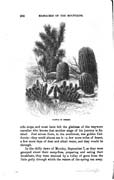
[p. 292]
In the chilly dawn of Monday, September 7, as they were
grouped about their camp-fires, preparing and eating their
breakfasts, they were stunned by a volley of guns from the
little gully through which the waters of the spring ran away.
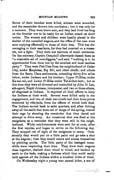
[p. 293]
Seven of their number were killed, sixteen were wounded,
and the remainder thrown into confusion; but it was only for
a moment. They were brave men, and they had lived too long
on the frontier not to be ready for an Indian attack on short
notice. The women and children were hastily placed in the
shelter of the corralled wagons, and the rifles of the men were
soon replying effectually to those of their foes. This was
discouraging to their assailants, for they had counted on a
massacre, not a fight. They were not warriors of much eminence.
On the contrary, Captain Campbell afterwards classed them as
"a miserable set of root—diggers," and said, "nothing is to be
apprehended from them but by the smallest and most careless
party." They were Pah-Utes from the neighborhood of Cedar
City, under Moquetas, Big Bill, and other chiefs; and others
from the Santa Clara settlements, extending thirty-five miles
below, under Jackson and his brother; Upper Pi-Edes, under
K-nar-rah, and Lower Pi-Edes under Tal-si-Gob-beth; but at this time they were all directed and controlled by John D. Lee,
sub-agent, Nephi Johnson, interpreter, and two or three others,
all disguised as Indians. It required all their efforts to keep
the Indians at their work. Several were killed early in the
engagement, and two of their war-chiefs had their knee-joints
shattered by rifle-balls, from the effects of which both died.
The Indians moved back to safer quarters, and, after driving
away all the cattle that were out of range of the spring, vented
their rage by shooting the remainder that they dared not
attempt to drive away. An occasional shot was fired at the
emigrants, as a reminder that they were still in the
neighborhood. White reinforcements were sent for at once, after
the first repulse, and began to arrive on the following day.
They stopped out of sight of the emigrants to camp.
Occasionally they would put on a little paint and go take a shot
at the wagons; then they would return and amuse themselves
by pitching quoits. The little party of the besieged
mean-while were improving their time. They drew their wagons
close together, chained them wheel to wheel, and banked up
earth to the beds, making a fortress which they could easily
hold against all the Indians within a hundred miles of them.
On Wednesday night a young man named Aden, a son of
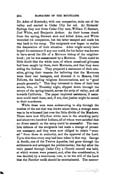
[p. 294]
Dr. Aden of Kentucky, with one companion, stole out of the
valley and started to Cedar City for aid. At Richards'
Springs they met three Cedar City men, William C. Stewart,
Joel White, and Benjamin Arthur. As their horses drank
from the spring, Stewart shot and killed Aden, and White
wounded his companion, but the latter escaped and made his
way back to the camp. The emigrants now began to realize
the desperation of their situation. Aden might surely have
hoped for assistance if any one could, for his father was known
to have saved the life of a Mormon bishop of the neighborhood;
yet he was assassinated by a Mormon. There could be
little doubt that the white men, of whom occasional glimpses
had been caught by them, were Mormons, and that they were
aiding the Indians. They prepared a statement of their
situation, giving their reasons for believing that the Mormons
were their real besiegers, and directed it to Masons, Odd
Fellows, the leading religious denominations, and to "good
people generally." This they intrusted to three of their best
scouts, who, on Thursday night, slipped down through the
arroyo of the spring-branch, across the strip of valley, and off
towards California. The paper implored assistance, if assistance could reach them, and, if not, that justice might be meted
to their murderers.
While these men were endeavoring to slip through the
meshes of the net that was drawn about them, a strange scene
was to be witnessed just over the little divide of the Meadows. There were now fifty-four white men in the attacking party
and about two hundred Indians, all of whom were satisfied that no direct assault on the camp could be successful. The
resolute defence of the emigrants had made a change of procedure
necessary, and they were now obliged to obtain
"counsel" from those in authority, and the approval of the Lord.
Up to this time every step had been taken in that way. George
A. Smith, one of the Twelve Apostles, had gone through the
settlements and arranged the preliminaries; the day after the
train passed through Cedar City a Church council was held, at which women were present, and, after due consideration, it
was decided, by a unanimous vote, to be the will of the Lord
that the Fancher outfit should be exterminated. The manner
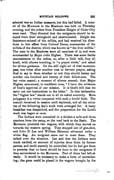
[p. 295]
selected was an Indian massacre, but this had failed. A council
of the Mormons in the Meadows was held on Thursday
evening, and the orders from President Haight of Cedar City
were read. They directed that the emigrants should be
decoyed from their stronghold and exterminated. Haight was
lieutenant–colonel of the militia, and had received his
directions to this effect from Colonel Dame, commander of the
militia of the district, which was known as "the Iron militia."
The men in the Meadows were all members of it, and were
commanded by Major John Higbee. There was some feeble
remonstrance to the orders, so, after a little talk, they all
knelt, with elbows touching, in "a prayer circle," and asked
for divine guidance. On the still night air of that mountain
pass, one voice after another rose in fervent prayer, asking
God to say to them whether or not they should betray and
murder one hundred and twenty of their fellow-men. The
last voice ceased; a moment of silence ensued; then Major
Higbee announced, in confident tone, "I have the evidence
of God's approval of our mission. It is God's will that we
carry out our instructions to the letter." In that declaration
the "higher law" stands out in all its naked enormity. Mere
polygamy is a virtue compared with such a devils' faith. The
council remained in session until daybreak, and all the minutiae
of the following day's work were arranged for. A hasty
breakfast was despatched, and the preparation for the Lord's
work was begun at once.
The Indians were concealed in a thicket a mile and three quarters from the camp, on the road back to the Basin. The
Mormons procured two wagons, with which they moved on
towards the western spring. They stopped out of gun-shot,
and John D. Lee and William Bateman advanced under a
white flag. An emigrant came out to meet them. They
talked over the situation. Lee said that the Indians were
much excited, on account of injuries done them by former
parties, and could scarcely be controlled, but he had got them
to promise that no harm should be done to the emigrants if
they surrendered to the Mormons. Part of them had left
already. It would be necessary to make a form of surrendering;
the guns could be placed in the wagons brought by the
JOHN D. LEE.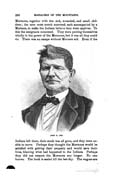
[p. 296]
Mormons, together with the sick, wounded, and small
children; the men must march unarmed, each accompanied by a
Mormon, to make the Indians believe they were captives. To
this the emigrants consented. They were putting themselves
wholly in the power of the Mormons, but it was all they could
do. There was no escape without Mormon aid. Even if the
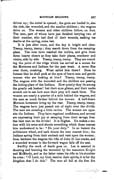
[p. 297]
driven up; the corral is opened; the guns are loaded in, also
the sick, the wounded, and the smaller children; the wagons
drive on. The women and older children follow, on foot.
The men, part of whom have just finished burying two of
their number, who had died of their wounds, making ten
deaths at the spring, come last.
It is just after noon, and the day is bright and clear. Tramp, tramp, tramp; they march down from the camping- place. The men have reached the militia, and give them three hearty cheers as they take their places, murderer and victim, side by side. Tramp, tramp, tramp. They are rounding the point of the ridge which has served as a screen for the Mormons and Indians for the past week. A raven flies over them, croaking. What called him there? Does he foresee that he shall peck at the eyes of brave men and gentle women who are looking at him? Tramp, tramp, tramp. The wagons with the wounded and the children are passing the hiding-place of the Indians. How quietly they lie among the gnarly oak bushes! but their eyes glisten, and their necks stretch out to see how soon their prey will reach them. The women are nearly a quarter of a mile behind the wagons, and the men as much farther behind the women. A half-dozen Mormon horsemen bring up the rear. Tramp, tramp, tramp. The wagons have just passed out of sight over the divide. The men are entering a little ravine. The women are opposite the Indians. They have regained confidence, and several are expressing their joy at escaping from their savage foes. See that man on the divide! It is Higbee. He makes a motion with his arms and shouts something which those nearest him understand to be: "Do your duty." In an instant the militiamen wheel, and each shoots the man nearest him; the Indians spring from their ambush and rush upon the women; from between the wagons the rifle of John D. Lee cracks, and a wounded woman in the forward wagon falls off the seat.
Swiftly the work of death goes on. Lee is assisted in
shooting and braining the wounded by the teamsters Knight
and McMurdy, and as the latter raises his riiie to his shoulder
he cries: "O Lord, my God, receive their spirits, it is for thy
kingdom that I do this." The men all fell at the first fire
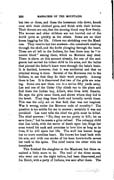
[p. 298]
but two or three, and these the horsemen ride down, knock
over with their clubbed guns, and finish with their knives.
Their throats are cut, that the atoning blood may flow freely.
The women and older children are not hurried out of the
world quite so quickly as the others. Some are on their
knees begging for life. Others run shrieking over the
Meadows. They receive but two answers—the tomahawk crashing
through the skull,and the knife plunging through the heart.
These are all left to the Indians, for fear there may be
"innocent blood " among them, which no Mormon may shed.
There is alarm on this account already, for one of the
emigrants had carried his infant child in his arms, and the bullet
that pierced the father's heart went through the babe's brain.
It is decided, however, that it was accidental and that no
criminal wrong is done. Several of the Mormons run to the
Indians, to see that they do their work properly. Among
them is Lee. It is discovered that two of the girls are missing.
Some one saw them run to a ravine fifty yards away.
Lee and one of the Cedar City chiefs run to the place and
find there the Indian boy, Albert, who lives with Hamlin.
He says the girls came there, and shows where they hid in
the brush. They drag them forth and brutally ravish them.
This was the only act on that field that was not inspired.
Was it wrong, under the Mormon code of morality? The
question is too subtle for me to answer; certainly it was not
punished. Lee next tells the chief the girls must be killed.
The chief answers: "No, they are too pretty to kill; let us
save them ;" but he meets a grim refusal. The unhappy child
that Lee holds, with the terror of death upon her, flings her
arms round his neck and promises to love him as long as he
lives, if he will spare her life. The wolf has keener fangs
but no more merciless heart. He throws her head back with
his arm, and with one stroke of his keen bowie-knife severs
her neck to the spine. The chief brains the other with his
tomahawk.
This finished the slaughter at the Meadows; but there
remained a little more to do. The trail of the three scouts,
who went out on the night before, had been discovered, and
Ira Hatch, with a party of Indians, was sent after them. The
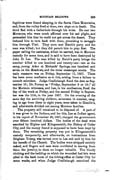
[p. 299]
fugitives were found sleeping, in the Santa Clara Mountains,
and, from the volley fired at them, two slept on in death. The
third fled with a bullet-hole through his wrist. He met two
Mormons, who were much afflicted over his sad plight, and
persuaded him that he could not get across the desert. They
induced him to turn back with them, promising to smuggle
him through Utah. They soon met Hatch's party and the
man was killed; but they did permit him to pray first. The
paper calling for assistance, which he carried, was in Mormon
custody for some time, and is said to have been destroyed by
John D. Lee. The man killed by Hatch's party brings the
number killed to one hundred and twenty-one —ten at the
camp, young Aden at Richards' Springs, one hundred and
seven on the Meadows, and the three messenger scouts. The
main massacre was on Friday, September 11, 1857. There
has been some confusion as to this, arising from a failure to
consult calendars. Judge Cradlebaugh fixed the date as
September 10; Dr. Forney as "Friday, September 9 or 10 ;" all
the Mormon witnesses, and Lee, in his confessions, fixed the
day of the week as Friday, and the second Friday in September
was the 11th, in the year 1857. On the evening of the
same day the surviving children, seventeen in number, ranging
in age from three to eight years, were taken to Hamlin's,
and afterwards divided out among Mormon families.
The property still remained to be disposed of. A part of
it was given to the Indians, and for this, Lee as Indian agent,
in his report of November 20, 1857, charged the government
over fifteen hundred dollars. The bodies of the dead were
searched by Higbee and Klingensmith, the Bishop of Cedar
City, and the money found is supposed to have been kept by
them. The remaining property was put in Klingensmith's
custody temporarily, and afterwards, on instructions from
Brigham Young, was turned over to Lee and sold by him for
the benefit of the Church. The bodies were stripped entirely
naked, and fingers and ears were mutilated in tearing from
them the jewelry, to them no longer valuable. The bloody
clothing and the bedding on which the wounded had lain were
piled in the back room of the tithing-office at Cedar City for
some weeks, and when Judge Cradlehaugh examined the

[p. 300]
room, eighteen months later, it still stank of them. These
goods were commonly known as "property taken at the siege
of Sevastopol." Carriages and wagons of the emigrants were
in use long afterwards, and some of the jewelry is said to be
worn yet in Utah. The value of all the property taken, as
nearly as it can be ascertained, was over $70,000. People
in Arkansas who saw the organization of the train estimated
its value at $100,000.
It was for many years a hotly debated question whether
Brigham Young was connected with this crime or not. To
those who were familiar with the subordination of the
Mormon Church, its system of espionage, its compulsory confessional,
its obedience to "counsel," and its prompt punishment
of everything contrary to the will of those in authority, his
guilt was a matter of course. But many did not believe it.
In 1875 he published a deposition in which he acknowledged
himself accessory after the fact, saying that, within two or
three months after the affair, Lee began giving him an
account of it, and, says the deposition, "I told him to stop, as,
from what I had already heard by rumor, I did not wish my
feelings harrowed up by a recital of detail." Lee and
Klingensmith say they reported it fully to him, and Hamlin says
he did also. To Lee, by his account, Young professed to be
much shocked by the killing of the women and children, but,
after considering it over-night, he said: "I have made that
matter a subject of prayer. I went right to God with it, and
asked him to take the horrid vision from my sight, if it were
a righteous thing that my people had done in killing those
people at the Mountain Meadows. God answered me, and at once the vision was removed. I have evidence from God
that he has overruled it all for good, and the action was a
righteous one and well intended. The brethren acted from
pure motives. The only trouble is that they acted a little
prematurely; they were a little ahead of time. I sustain you
and all of the brethren for what they did. All that I fear is
treachery on the part of some one who took a part with you,
but we will look to that." There is testimony also that he
was accessory before the fact, and his proclamation, that "No
person shall be allowed to pass or repass, into or through or
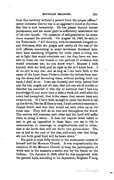
[p. 301]
from this territory without a permit from the proper officer,"
surely indicates that he was in an aggressive mood at the time.
But this is now immaterial. He has passed beyond human
punishment, and his moral guilt is sufficiently established out
of his own mouth. On occasions of self-gratulation he
sometimes exposed his methods. On August 12, 1860, he said, in
the Tabernacle: "All the army, with its teamsters, hangers-on,
and followers, with the judges and nearly all the rest of the
civil officers, amounting to some seventeen thousand men,
have been searching diligently for three years to bring one
act to light that would criminate me; but they have not been
able to trace out one thread or one particle of evidence that
would criminate me; do you know why? Because I walk
humbly with my God, and do right so far as I know how. I
do no evil to any one; and as long as I can have faith in the
name of the Lord Jesus Christ to hinder the wolves from tearing
the sheep and devouring them, without putting forth my
hand,I shall do so. I can say honestly and truly, before God
and the holy angels and all men, that not one act of murder or
disorder has occurred in this city or territory that I had any
knowledge of, any more than a babe a week old, until after the
event had transpired; that is the reason they cannot trace any
crime to me. If I have faith enough to cause the devils to eat
up the devils, like the Kilkenny cats, I shall certainly exercise it.
Joseph Smith said that they would eat each other up as did
those cats. They will do so here and throughout the world.
The nations will consume each other and the Lord will suffer
them to bring it about. It does not require much talent or
tact to get up opposition in these days; you see it rife in
communities, in meetings, in neighborhoods, and in cities;
that is the knife that will cut down this government. The
axe is laid at the root of the tree, and every tree that bringeth
not forth good fruit will be hewn down."
His guilt is most fully shown in the subsequent course of
himself and the Mormon Church. It was unquestionably the
intention of the Mormon Church to keep the participation of
white men in the massacre a secret, and lay the blame on the Indians. On January 6, 1858, after he was acquainted with
the general facts, according to his deposition, Brigham Young
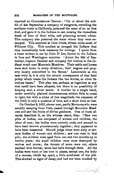
[p. 302]
reported to Commissioner Denver: "On or about the middle of last September a company of emigrants, travelling the southern route to California, poisoned the meat of an ox that died, and gave it to the Indians to eat, causing the immediate
death of four of their tribe, and poisoning several others. This company also poisoned the water where they were encamped. This occurred at Corn Creek, fifteen miles south of Fillmore City. This conduct so enraged the Indians that they immediately took measures for revenge. I quote from a letter written to me by John D. Lee, farmer to the Indians in Iron and Washington counties. 'About the 22d of September, Captain Fancher and company fell victims to the Indians' wrath near Mountain Meadows. Their cattle and horses were shot down in every direction; their wagons and property mostly committed to the flames.' Lamentable as this case truly is, it is only the natural consequence of that fatal policy which treats the Indians like the wolves, or other ferocious beasts." This plan was, perhaps, as ingenious as any that could have been adopted, but there is no possibility of keeping such a crime secret. A murder by a single hand, under carefully planned circumstances, seldom fails to come to light, but with a crime of this magnitude the exposure of the truth is only a question of time, and a short time at that.
On October 2, 1857, eleven men, partly Mormons,who were
secretly escaping from Utah, passed through Mountain Meadows and saw the fruits of divine guidance. One of them afwards described it, on the witness-stand, thus: "Saw two
piles of bodies, one composed of women and children, the
other of men; the bodies were entirely nude, and seemed to
have been thrown promiscuously together; they appeared to
have been massacred. Should judge there were sixty or
seventy bodies of women and children; saw one man in that
pile; the children were aged from one and two months up to
twelve years; the small children were most destroyed by
wolves and crows; the throats of some were cut, others
stabbed with knives; some had balls through them. All the
bodies were more or less torn to pieces, except one, the body
of a woman, which lay apart, a little southwest of the pile.
This showed no signs of decay, and had not been touched by
SCENE OF MASSACRE.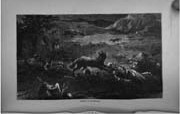
[p. 303]
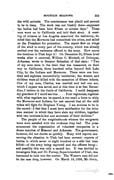
[p. 305]
the wild animals. The countenance was placid and seemed
to be in sleep. The work was not freshly done—supposed
the bodies had been here fifteen or sixteen days." These
men went on to California and told their story. A meeting
of citizens at Los Angeles examined the testimony, decided that the Mormons had committed the crime, and called
on the President for protection. The report flew on wings
of the wind to every part of the country, which was already
excited over the resistance offered to the army. How secret
the brethren in Utah kept it! On December 31, fifteen brief weeks after it occurred, William C. Mitchell, of Dubuque,
Arkansas, wrote to Senator Sebastian of that state: "Two
of my sons were in the train that was massacred, on their
way to California, three hundred miles beyond Salt Lake
City, by the Indians and Mormons. There were one hundred
and eighteen unmercifully butchered; the women and
children were all killed with the exception of fifteen infants. One of my sons, Charles, was married and had one son,
which I expect was saved, and at this time is at San Bernardino,
I believe in the limits of California. I could designate
my grandson if I could see him .... Four regiments, together
with what regulars can be spared, is too small a force to whip
the Mormons and Indians, for rest assured that all the wild
tribes will fight for Brigham Young. I am anxious to be in
the crowd—I feel that I must have satisfaction for the inhuman
manner in which they have slain my children, together
with two brothers-in-law and seventeen of their children."
The people of the neighborhoods whence the emigrants
went were satisfied with the evidence they had. The press
announced the organization of volunteer companies in a
dozen counties of Missouri and Arkansas. The government,
however, did not decide so quickly. Many wild reports
concerning the situation in Utah had been curren—reports of battles in which seven or eight hundred on a side had been
killed—of the army being captured and the officers hung—
and possibly this was only a canard too. It was decided to
investigate first, and Dr. Forney, Superintendent of Utah, was
instructed to look into the matter. The Western men did not
let the case drop, however. On March 18, 1858, Mr. Gwin,
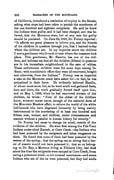
[p. 306]
of California, introduced a resolution of inquiry in the Senate, asking what steps had been taken to punish the murderers of the one hundred and eighteen emigrants. He said he knew the Indians were guilty, and it had been charged, and was
believed, that the Mormons were, but at any rate the guilty
should be punished. On June 22, 1858, Dr. Forney reported:
"It affords me great pleasure to inform you, and the friends
of the children in question through you, that I learned to-day
where the children are. In my inquiries about the children
I met a gentleman who lives at or near where the massacre took
place. This gentleman, Mr. Hamlin, has one of the children, and informs me that all the children (fifteen) in question
are in his immediate neighborhood in the care of whites.
These unfortunate children were for some days among Indians;
with considerable effort they were all recovered, bought
and otherwise, from the Indians." Forney was as impartial
a man as the Mormons could have asked for—in fact, he was
prejudiced in their favor. He evidently believed Hamlin,
of whom more anon, but, as he went south and gathered facts,
here and there, the truth gradually forced itself upon him,
and on May 1, 1859, when he had recovered sixteen of the
children, he wrote: " Four of the oldest of the children
know, WITHOUT DOUBT KNOW, enough of the material facts of
the Mountain Meadow affair, to relieve the world of the white hell-hounds who have disgraced humanity by being mainly
instrumental in the murdering of at least one hundred and fifteen men, women, and children, under circumstances and
manner without a parallel in human history for atrocity."
Dr. Forney had cause to change his mind, outside of the evidence of the children. He went first among the Pah-Vant
Indians under chief Kanosh, at Corn Creek—the Indians who had been poisoned by the emigrants and taken vengeance on
them. He found that none of them had been poisoned by the
waters of the spring; that the spring ran so strong that a barrel
of arsenic would not have poisoned it; that an ox belonging
to Dr. Ray, a Mormon living at Fillmore City, had died
about the time the emigrants were camped at Corn Creek, from I
eating a poisonous weed—a not unusual occurrence—and some
Indians who ate of the ox were poisoned, but they had made
KANOSH.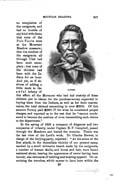
[p. 307]
In the spring of 1859 a company of dragoons and two
companies of infantry, under Captain R. P. Campbell, passed
through the Meadows and buried the remains. Theirs was
the last view of the Lord's work. Dr. Charles Brewer, in
charge of the burying-party, reported: "At the scene of the
First attack, in the immediate vicinity of our present camp,
marked by a small defensive trench made by the emigrants,
a number of human skulls, and bones and hair, were found
scattered about, bearing the appearance of never having been
buried; also remnants of bedding and wearing apparel. On
examining the trenches, which appear to have been within the
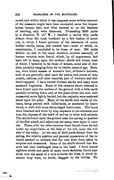
[p. 308]
corral, and within which it was supposed some written account
of the massacre might have been concealed, some few human
bones, human hair, and what seemed to be the feathers
of bedding, only were discerned. Proceeding 2500 yards
in a direction N. 15° W., I reached a ravine fifty yards
distant from the road, bordered by a few bushes of scrub
oak, in which I found portions of the skeletons of many
bodies—skulls, bones, and matted hair—most of which, on
examination, I concluded to be those of men. 350 yards
farther on, and in the same direction, another assembly of
human remains were found, which, by all appearance, had
been left to decay upon the surface—skulls and bones, most
of which I believed to be those of women, some also of
children, probably ranging from six to twelve years of age. Here,
too, were found masses of women's hair, children's bonnets,
such as are generally used upon the plains, and pieces of lace,
muslin, calicoes, and other material, part of womcn's and
children's apparel. I have buried thirteen skulls, and many more
scattered fragments. Some of the remains above referred to
were found upon the surface of the ground, with a little earth
partially covering them, and, at the place where the men were
massacred, some lightly buried, but the majority were scattered
about upon the plain. Many of the skulls bore marks of violence,
being pierced with bullet-holes, or shattered by heavy
blows, or cleft with some sharp-edged instrument. The bones
were bleached and worn by long exposure to the elements, and
bore the impress of the teeth of wolves or other wild animals.
The skulls found upon the ground near the spring, or position
of the first attack, and adjoining our camp, were eight in number.
These, with the other remains there found, were buried,
under my supervision, at the base of the hill, upon the hillside
of the valley. At the rate of 2500 yards distant from the
spring, the relative position and general appearance of the
remains seemed to indicate that the men were there taken by
surprise and massacred. Some of the skulls showed that
fire-arms had been discharged close to the head. I have buried
eighteen skulls and parts of many more skeletons, found scattered
over the space of a mile towards the lines, in which
direction they were, no doubt, dragged by the wolves. No
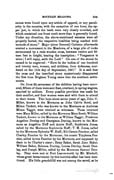
[p. 309]
names were found upon any article of apparel, or any peculiarity
in the remains, with the exception of one bone, the upper
jaw, in which the teeth were very closely crowded, and
which contained one front tooth more than is generally found.
Under my direction, the above mentioned remains were all
properly buried, the respective localities being marked with
mounds of stone." Major (since General) Carleton afterwards
erected a monument in the Meadows, of a large pile of rocks surmounted by a rude wooden cross, between twelve and fifteen
feet in height, bearing the inscription: "Vengeance is
mine; I will repay, saith the Lord." On one of the stones he
caused to be engraved: "Here lie the bodies of one hundred and twenty men, women, and children, from Arkansas, murdered
on the 11th day of September, 1857." It is said that the cross and the inscribed stone mysteriously disappeared
the first time Brigham Young came into the southern
settlements.
On June 29, seventeen of the children having been recovered, fifteen of them were sent East, overland, in spring-wagons,
escorted by soldiers. Every possible provision was made for
their comfort, and four women were sent with them to attend
to their wants. Two boys about seven years of age, John C.
Miller, known to the Mormons as John Calvin Sorel, and
Milum Tackett, who was known to the Mormons as Ambrose
Miram Taggit, were retained as witnesses. Those returned
were Mary Miller, called by the Mormons Mary Sorel; William Tackett, known to the Mormons as William Taggit; Prudence Angeline Dunlap and Georgiana Dunlap, known to the Mormons as Angeline Huff and Annie Huff; Sophronia Jones, called by the Mormons Sophronia Huff; T. M. Jones, called by the Mormons Ephraim W. Huff; Kit Carson Fancher, called Charley Fancher by the Mormons; his cousin Tryphena Fancher, called Annie Fancher by the Mormons, and supposed by them to be Charley's sister; Betsy Baker, Sarah Jane Baker,
William Baker, Rebecca Dunlap, Louisa Dunlap, Sarah Dunlap, and Joseph Miller, called by the Mormons Samuel Dunlap.
They were met at Fort Leavenworth by Mr. Mitchell, whose great bereavement by this horrible afair has been
mentioned. His little grandchild was not among the saved, as he
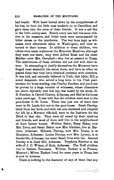
[p. 310]
had hoped. With heart bowed down by the completeness of his loss, he bore the little ones tenderly on to Carrollton and gave them into the arms of their friends. It was a sad day in the little county-seat. Nearly every one had lost some relative in the massacre, and bitter tears were accompanied by
bitter curses on the murderers. The two boys kept as witnesses were afterwards taken to Washington, and then returned to their homes. In addition to these children, two others were made orphans at the Mountain Meadows, although they were not there; they were Alfred Rush and his sister Martha—now Mrs. Campbell—who live at present in Texas. The misfortunes of these children did not end with their return. In attempting to justify themselves the Mormons have forged most shameful lies about them, and have so often
repeated them that they have obtained credence with outsiders.
It was told, and currently believed in Utah, that Idaho Bill, a noted desperado who served a long term in the Utah penitentiary for horse-stealing, was Charley Fancher, and yet it can be proven by a large number of witnesses, whose characters are above reproach, that this boy was raised by his uncle, H. B. Fancher, in Carroll County, Arkansas, and died at his house some years ago. It was told that the children were sent to the poor house in St. Louis. There was just one of them that went to St. Louis, but not to the poor-house. Sarah Dunlap, blind from her birth, and with one arm shattered and crippled for life by a Mormon rifle-ball, went to the Institute for the Blind in that city. They were all raised by their relatives and friends, and most of them still live in the neighborhood of their former homes. William Baker, Betsy Baker, now
Mrs. Terry, and Sarah Baker, now Mrs. Gladden, live at Harrison, Arkansas; Rebecca Dunlap, now Mrs. Evans, is at
Hampton, Arkansas; Louisa Dunlap, now Mrs. Lynton, is at Scottsville, Arkansas; her sister Sarah lives with her. Samuel Dunlap is at Lead Hill, Arkansas. Tryphena Fancher is the wife of J. C. Wilson, of Rule, Arkansas. The Huff children
live in Eastern Tennessee. William Tackett is at Protem, Missouri; Milum Tackett lived for some years in Texas, but is now in Arizona.
There is nothing in the character of any of them that any
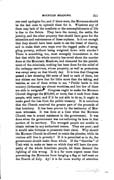
[p. 311]
one need apologize for, and if there were, the Mormons should
be the last ones to upbraid them for it. Whatever any of
them may lack of the comforts or the accomplishments of life
is due to the Saints. They have the money, the cattle, the jewelry, and the other property that should have gone for the
education and maintenance of these orphans. Is it not enough
that they should have been made to eat the bread of charity,
aud to make their own ways over the rugged paths of
struggling poverty, without being weighted down with slander?
There is something, too, most strangely inconsistent in the
fact that while the whole country has raved about the murder
done at the Mountain Meadows, and clamored for the punishment of the criminals, nothing has been done for the relief of the unhappy survivors, whose property, as well as protectors,
was swept away on that bloody day. It is true that Congress
passed a law donating 320 acres of land to each of them, but
any citizen can have that for little more than the taking, and
besides, as one of them writes to me, "Public lands in this
country (Arkansas) are almost worthless, and but few of them are able to emigrate. Congress ought to make the Mormon Church disgorge the $70,000, or more, that it took from these
people, with usury, and if it be not able to do so, it ought to
make good the loss from the public treasury. It is notorious
that the Church received the greater part of the proceeds of
that butchery. It has been proven by the testimony of Mormon
witnesses. It was done at a time when the Mormon
Church was in armed resistance to the government. It was
done when the government was not enforcing its laws in that
portion of its territory. The wronged people are unable to
obtain redress by any authorized means. They are poor; and
it would take fortunes to prosecute their claim. Why should the Mormon Church be allowed to retain the plunder, while its
victims still live in poverty? If it is permitted so to do, the
government should make them whole. If the "Gentiles" of
Utah wish to make an issue on which they will have the sympathy of the whole American people, let them demand the
righting of this wrong. It is a far more urgent cause than
preventing the Mormons from hanging a flag at half-mast on
the Fourth of July. Ay! it is far more worthy of attention

[p. 312]
than prohibiting a half-dozen female cranks from living with
a male fanatic, that the Mormon Church should give back to
the rightful heirs the property that it took with bloody hands,
on September 11, 1857.
At the same time that Forney was pursuing his inquiries, Judge John Cradlebaugh, one of the associate justices of the Supreme Court of Utah, came south to hold court there, and to aid in investigating the massacre. He was accompanied
by Brigham Young, who was "extending every assistance in ferreting out the perpetrators of the crime." John D. Lee says that while on this trip Young said to a congregation of the faithful, at Cedar City: "I am told that there are many of the brethren who are willing to swear against the brethren
who were engaged in that affair. I hope there is no truth in
this report. I hope there is no such person here under the
sound of my voice. But if there is I will tell you my
opinion of you, and the fact so far as your fate is concerned.
Unless you repent at once of that unholy intention, and keep
the secret of all that you know, you will die a dog's death,
and be damned, and go to hell. I do not want to hear of any
more treachery among my people." Inasmuch as Young admits in his deposition that he was familiar with the facts of
the affair long before this; inasmuch as apostates from that
section corroborate Lee's statement; inasmuch as no one was brought to justice at the time, we may fairly believe this
statement to be true. There was evidence obtained, nevertheless,
and apostates in the South promised that, if Judge
Cradlebaugh would hold court with enough troops at hand to protect the witnesses and the court, they would insure the
conviction of nearly all the guilty parties. Warrants were
issued for thirty-eight of the assassins, but just then another
complication occurred. A great outcry had been raised because
troops had been stationed near the court in Provo, during some recent Danite trials, and General Johnston received instructions that the troops must be used only as a posse comitatus, on due call of the executive department. He notified
Judge Cradlebaugh of this fact, and the judge, having had experience in holding a court of justice in a Mormon community,
without protection, very sensibly dropped the Mountain
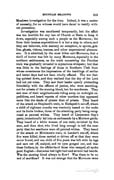
[p. 313]
Meadows investigation for the time. Indeed, it was a matter
of necessity, for no witness would have dared to testify without
protection.
Investigation was smothered temporarily, but the affair
was too horrible for any ban of Church or State to keep it
down, especially among such a people as the Mormons; for
from their intense superstitions it is but a step to others, and
they are believers, with scarcely an exception, in spirits, goblins,
ghosts, visions, trances, and other supernatural phenomena.
It is admitted, by the most bitter anti-Mormons, that a
thrill of horror was felt by many Mormons, especially in the
northern settlements, as the truth concerning the Fancher
train was gradually revealed in mysterious whispers; but that
was little to the feelings of those in Southern Utah from whose consciences the impressions of the teachings of earlier
and better days had not been wholly effaced. The war feeling
quieted down, and they realized that the day of the Lord
had not yet come. They saw their leader openly pretending
friendship with the officers of justice, who were searching,
not for priests of the atoning blood, but for murderers. They
saw men of their neighborhoods riding away on midnight
expeditions, and heard reports of other murders that appeared
more like the deeds of pirates than of priests. They heard
of the attack on Shepherd's train, in Hedspeth's cut-off, where
a child of eighteen months was wantonly tossed on the rocks
and its limbs broken, three of the attacking party being recognized
as painted whites. They heard of Lieutenant Gay's
party, intentionally led into an ambuscade by a Mormon guide.
They heard of a white woman of one train, ravished by five
men, and then shot, who lived long enough to tell the next
party that her assailants were all painted whites. They heard
of the attack on Miltimore's train, in Lander's cut-off, where
five were killed, three carried or driven off so that they were
never found, and one child of five years was left with its legs
and ears cut off, scalped, and its eyes gouged out, and that
these Indians, by the affidavits of those who escaped, all spoke
good English—that some had light hair and several had beards.
Was the atoning blood always to flow? Was there to be no
end of sacrifices? It was not strange that the Mormons came
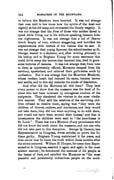
[p. 314]
to believe the Meadows were haunted. It was not strange that men told in low tones how the spirits of the dead met
nightly at the old camp and reenacted the bloody tragedy. It
was not strange that the lives of those who neither dared to
speak while living, nor to die without speaking, became hideous
nightmares. It was not strange that a lad of Beaver drank deeply of rum, without staggering, and horrified his
acquaintances with recitals of the visions that he saw. It
was not strange that young Spencer, the school-teacher at St. George, wasted to a skeleton, and, after writing piteously to his bishop and to Brigham Young for some assurance that could drive away the terrors that haunted him, died in grewsome tortures of remorse. It was not strange that, from time to time, as opportunity offered, Mormons escaped from the territory, apostatized, and relieved their guilt-laden souls by confession. But it was strange that the Mountain Meadows, whose verdant heath had induced its name, became barren
and sterile, and to this day remains the abode of desolation.
And what did the Mormons all this time? They bent
every power to show that the massacre was the deed of
Indians who had been incensed by outrageous conduct of the
emigrants. They slandered the victims in the most vindictive
manner. They said the relatives of the surviving children
refused to receive them, saying that "they were the
children of thieves, outlaws, and murderers, and they would
not take them, they did not want anything to do with them,
and would not have them around their houses," and that in
consequence the children were sent to "the poor-house in
St. Louis." There was not a Mormon of any prominence who did not know the truth about the massacre, and not one who
did not take part in this deception. George Q. Cannon, late Representative in Congress, wrote articles to prove the
Indians guilty. Brigham Young maintained it for years, and then swore that he knew the truth within three months after
the crime occurred. William H. Hooper, for some time Representative
in Congress, asserted it again and again in the most
solemn manner; he denounced the enemies of his people as
the basest of liars, and extolled the Mormons as "the most
peaceful and persistently industrious people on the
GEORGE Q. CANNON.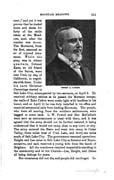
[p. 315]
But conscience did not die, and people did not forget.
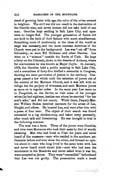
[p. 316]
Instead of growing faint with age, the color of the crime seemed
to heighten. The civil war did not result in the destruction of
the Gentile men, and seven women did not take hold of one
man. Gentiles kept settling in Salt Lake City, and apostates no longer fled. The younger generation of Saints did
not hold to the faith of their fathers with much steadfastness.
Something more of conformity to the ideas of the world at
large was necessary, and the more extreme doctrines of the
Church were put in the background. Lee was "cut off" from fellowship; so were Bill Hickman and other Danites. Lee
went on a "mission" outside the limits of Utah. He kept a ferry on the Colorado, down in the deserts of Arizona, where for convenience he was known as Major Doyle. In January,
1874, the Gentiles held a public meeting in Salt Lake City, and a committee of forty-five drafted a memorial to Congress,
showing the utter perversion of justice in the territory.
Congress passed a law which took the selection of jurors out of
the control of the Mormon Church, and it was left with no
refuge but the perjury of witnesses, and such Mormon jurors
as came on in regular order. In the same year Lee came up to Panguitch, on the Sevier, to visit some of his younger wives (he had eighteen, besides one whom he married "for her
soul's sake," and did not count). While there, Deputy-
Marshal William Stokes received warrants for the arrest of Lee, Haight, and others. He located Lee, and went after him with
a posse of four men. The object of their search was found
concealed in a log chicken-coop, and taken away peaceably,
after much talk and threatening. He was brought to trial in
the following summer.
The trial was a farce. Three of the jurors were Gentiles,
and nine were Mormons who took their seats by dint of sturdy
swearing. Men who had lived in Utah for years and never heard of the massacre—men who resided in the southern
settlements before and ever since the crime, and formed no opinion
about it—men who long lived in the same town with Lee and never heard much about him—men who had seen the
monument in the Meadows and never asked what it was for, were accepted as jurors. They were "counselled" beforehand
that Lee was not guilty. The prosecution made a much
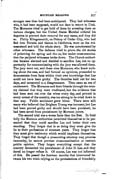
[p. 317]
stronger case than had been anticipated. They had witnesses
who, it had been supposed, would not dare to return to Utah. The Mormons tried to get hold of them by arresting them on
various charges, but the United States Marshal ordered his
deputies to prevent their removal for any cause, and they did
so. Philip Klingensmith, ex-Bishop of Cedar City, who had
fled into Nevada and thence to California, went on the
witness-stand and told the whole story. He was corroborated by
other witnesses. The defence tried to prove the old stories
of poisoning the spring and the ox, but under cross-examination
the perjured witnesses broke down. The Church authorities
became alarmed and decided to sacrifice Lee, but no
opportunity for communicating with the jury was allowed them.
The jury went out, and these nine Mormons, who knew nothing
about the case, and had formed no opinions, proceeded to
demonstrate from facts within their own knowledge that Lee could not have been guilty. The Gentiles held out for two
days, and consented to a disagreement. Then came an era of
excitement. The Mormons and their friends through the country
claimed that they were vindicated, but the evidence that
had been sent out over the wires every day, and printed in
every corner of the country, was too strong to be cried down in
that way. Public sentiment grew bitter. There were still
many who believed that Brigham Young was innocent, but Lee
had been proved guilty and should have been punished; he
had been saved from punishment by Mormon jurors.
The second trial was a worse farce than the first. In fatal
folly the Mormon authorities permitted themselves to be
persuaded that they could sacrifice Lee and better their own standing. They forgot that in so doing they must give the
lie to their professions of nineteen years. They forgot that
they must give testimony which would implicate themselves.
They forgot that though a prosecuting attorney may promise
immunity, he cannot prevent cross-examination or restrain
public opinion. They forgot everything except that the
country demanded the punishment of John D. Lee, and they dared no longer refuse it. Of course, Lee was not informed of this. He passed the fourteen months that intervened between
his two trials relying on the protestations of friendship
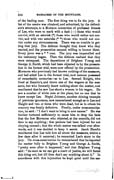
[p. 318]
of the leading men. The first thing was to fix the jury. A
list of the venire was obtained, and submitted, by the
defendant's attorneys, to a Mormon committee of professed friends
of Lee, who were to mark with a dash (—) those who would convict, with an asterisk (*) those who would rather not convict,
and with two asterisks (* *) those who would not convict
under any circumstances. There was no trouble in
getting that jury. The defence thought they knew who they
wanted, and the prosecution seemed willing to humor them.
Every juror was a * * man. The jury was impanelled and
the testimony began. Then the defence realized that they
were entrapped. The depositions of Brigham Young and
George A. Smith, which had been objected to by the prosecution in the former trial, were now offered by the prosecution.
Mormons who previously had known nothing of the massacre,
and had aided Lee in the former trial, now became possessed of remarkable memories—as to Lee. Samuel Knight, who
lived at Hamlin's, and drove one of the wagons at the massacre, but who formerly knew nothing about the matter, now
recollected that he saw Lee shoot a woman in his wagon. He saw a number of white men at the place, but no one that he
knew except Lee. Nephi Johnson, another shining example of previous ignorance, now remembered enough as to Lee and Haight and two or three who were dead, but as to others his memory was fatally defective. Finally, under cross-examination, he said: "I don't want to bring in new names." He was
further tortured sufficiently to cause him to drop the facts
that the few Mormons who objected, at the councils, did not
dare to say anything; that persons had been injured for not
obeying counsel; that the whole matter was talked over
afterwards, and it was decided to keep it secret. Jacob Hamlin recollected that Lee told him all about the massacre, within a few days after it occurred; he recounted Lee's story to the jury. On cross-examination he remembered that he reported
the matter fully to Brigham Young and George A. Smith,
"pretty soon after it happened," and that Brigham Young said: "As soon as we can get a court of justice, we will ferret
this thing out, but till then don't say anything about it." In
accordance with this injunction he kept quiet until the second
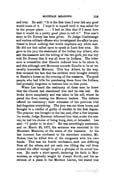
[p. 319]
trial. He said: "It is the first time I ever felt any good
would come of it. I kept it to myself until it was called for
in the proper place .... I had an idea that if I came here
that it would be a pretty good place to tell it." This man's
story to Dr. Forney has been given. To Judge Cradlebaugh
and various military officers who investigated the affair he
professed to know nothing that would implicate any white man.
He did not feel called upon to speak at Lee's first trial. He gave to the jury the statement of the Indian boy Albert, who
saw the massacre and the killing of the two girls, yet this boy told Dr. Forney that it was all done by Indians. The inference is irresistible that Hamlin induced him to lie about it,and this although anti-Mormons concede Hamlin to be an unusually honorable Mormon. This boy Albert, by the way, first revealed the fact that the children were brought directly to Hamlin's house on the evening of the massacre. The good people, who had bills for purchasing them from the Indians,
had probably forgotten to instruct him on that point.
When Lee heard the testimony of these men he knew
that the Church had abandoned him and he was lost. He
broke down completely and was taken to his cell, where he
paced the floor, cursing the Mormon leaders. The defence
offered no testimony; their witnesses of the previous trial
had forgotten everything. The jury was out three hours, and
brought in a verdict of guilty of murder in the first degree.
The prisoner was brought to the bar, and, after a few impressive
words, Judge Boreman informed him that, under the statute,
he had his choice of being hung, shot, or beheaded. Lee said: "I prefer to be shot." He was accordingly sentenced,
and on March 23, 1877, the sentence was executed in the
Mountain Meadows, at the scene of the massacre. At the last moment Lee confessed to his attendant minister, Mr. Stokes, that he killed five of the emigrants with his own
hands. This was his fourth confession, each one differing
from all the others, and yet each one lifting the veil from
around the affair enough to give a glimpse of its actual
horrors. He made a short speech, declaring his faith in
Mormonism, as originally taught by Joseph Smith, and his assurance of a place in the Mormon heaven, but stated that
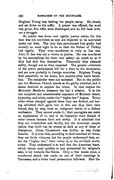
[p. 320]
Brigham Young was leading the people astray. He closed, and sat down on his coilin. A prayer was offered, the word
was given, live rifles were discharged, and he fell back without
a struggle.
So justice was done—not rightly justice either, for this
man was not convicted as men are required to be convicted
under our laws. The jury that pronounced him guilty had
morally no more right to do so than the Sultan of Turkey
had legally. They were murderers as truly as Lee was.
John D. Lee was not a victim to justice. He was murdered
by his accomplices for their own safety—as much so as if
they had shot him themselves. Personally they attained
safety, though not as they expected. The greater criminals
of the active participants hid for a time in the mountains,
and are now probably in foreign countries. Brigham Young
died peacefully in his home, five months after Lee's execution.
The remainder were not molested. But in the public
eye the Mormon Church stands as the guilty criminal, and it
seems destined to expiate the crime. In that respect the
Mountain Meadows massacre has had a mission. It is the
one complete and unanswerable exposure of Mormon deceit
hypocrisy, and crime, under the "higher law" dogma. Every
other crime charged against them they can defend, not having
admitted their guilt, but in this one they have been
forced, step by step, from an indignant denial to a defiant
confession. They cannot evade it; their apologists can make
no explanation of it; and in its lustration their denials of
other crimes become faint and sickly. It is admitted that
they are industrious and thrifty, but the American people
realize that thrift has its crimes as dark as any of those of
dissipation. Jonas Chuzzlewit was thrifty; so was Judas
Iscariot. It is true that, according to their standard of virtue,
they are fairly virtuous, but the people understand that, under
the "higher law," their virtue is, to the civilized world,
crime. They understand it so well that the American heart,
which warms most quickly to any persecuted for religion's
sake, is icy towards the Saints. Only a few weeks since, a
murderous attack was made on one of their meetings in
Tennessee, and a bitter local persecution followed. Had the
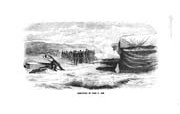
[p. 321]
EXECUTION OF JOHN D. LEE.
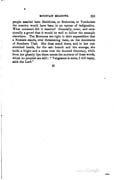
[p. 323]
people assailed been Buddhists, or Brahmins, or Voudooists the country would have been in an uproar of indignation. What comment did it receive? Generally, none; and occasionally a growl that it would be well to follow the example elsewhere. The Mormons are right in their superstition that a Nemesis stands, ever threatening them, on the mountains of Southern Utah. She does stand there, and in her outstretched hands, for the ash-branch and the scourge, she holds a blight and a curse over the doomed theocracy, while from her ghastly lips there comes the murmur of those words, which no prophet can still: "Vengeance is mine, I will repay, saith the Lord."